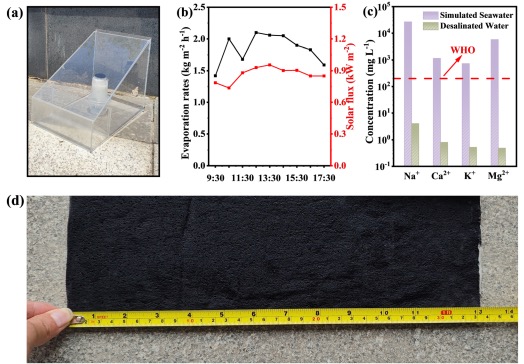| Aug 22, 2024 |
Floatable solar device cleans water and tackles pollutants in one smart solution
(Nanowerk News) The quest for advanced technologies that address both clean water regeneration and pollutant degradation has become increasingly critical. Recent research presents a novel solution, as reported in Materials Horizons ("Monolith floatable dual-function solar photothermal evaporator: efficient clean water regeneration synergizing with pollutant degradation").
|
|
In this study, led by Assistant Professor Edison Ang Huixiang at the National Institute of Education/Nanyang Technological University, researchers have developed an innovative evaporator by in situ confining nanometric CuFe2O4 and plasmonic Cu into graphitic porous carbon nanofibers (CNF) using electrospinning and controlled graphitization.
|
|
These materials were integrated onto a melamine sponge (S-FeCu/CNF) through a calcium ion-triggered crosslinking method with sodium alginate (SA). This approach provides a robust and efficient system for water treatment.
|
|
The FeCu/CNF graphitic porous carbon demonstrated superior light absorption properties (≥95%) and was securely anchored on the sponge, preventing salt deposition through the calcium ion-triggered SA crosslinking. The evaporator achieved an impressive solar-vapor conversion efficiency with an evaporation rate of 1.61 kg m-2 h-1 under one sun irradiation. Even in a 20% NaCl solution, it maintained a high evaporation rate of 1.54 kg m-2 h-1 while demonstrating excellent resistance to salt buildup and stability.
|
 |
| (a) Diagram of the compact evaporation apparatus. (b) Evaporation rate changes of the S-FeCu/CNF-4 device with varying solar radiation. (c) Metal ion concentration changes before and after desalination. (d) Assembly process of the large-scale evaporator. (Image: Reproduced from DOI: 10.1039/D4MH00696H with permission by Royal Society of Chemistry)
|
|
The dual functionality of the S-FeCu/CNF evaporator extends beyond water evaporation. It also acts as a heterogeneous catalyst to activate peroxymonosulfate (PMS), leading to rapid degradation of pollutants. The system exhibited excellent catalytic cycling stability and produced clean water that meets World Health Organization (WHO) standards.
|
|
"This monolithic design not only enhances water regeneration but also significantly improves pollutant degradation, providing a promising solution for desalination and wastewater treatment," says Ang.
|
|
The study highlights a significant advancement in integrating solar photothermal and catalytic processes into a single monolithic system, paving the way for more efficient and sustainable water treatment technologies. By combining effective light absorption with advanced oxidation processes, this approach offers a valuable contribution to addressing global water and pollution challenges.
|
|
"With further development, our innovative evaporator could become a key technology in sustainable water treatment, aiding in the quest for cleaner water and more effective pollutant management," Ang concludes.
|

